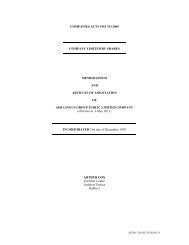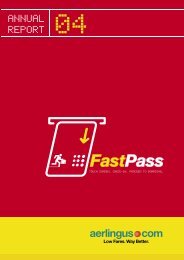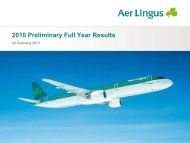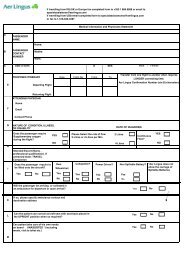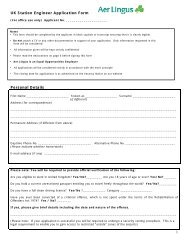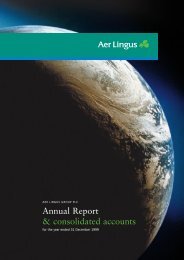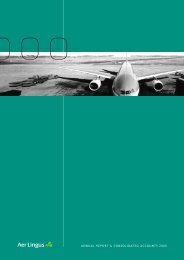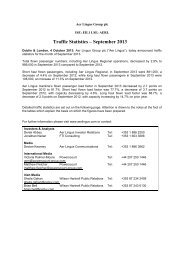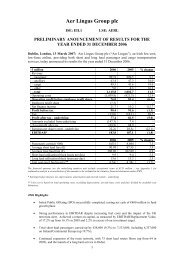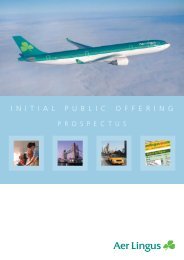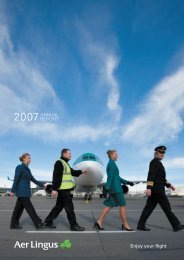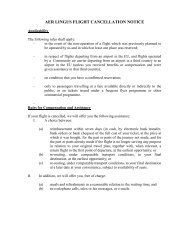annual report 2009 - Aer Lingus
annual report 2009 - Aer Lingus
annual report 2009 - Aer Lingus
You also want an ePaper? Increase the reach of your titles
YUMPU automatically turns print PDFs into web optimized ePapers that Google loves.
62 Financial Statements <strong>Aer</strong> <strong>Lingus</strong> Group Plc – Annual Report <strong>2009</strong>Notes to the Consolidated Financial Statements [continued]2 Summary of significant accounting policies [continued]For defined contribution schemes, the Group pays contributions into the pension schemes in accordance with the trust deed.The Group has no further payment obligations once the contributions have been paid. The contributions are recognised as employeebenefit expenses when they are due. Prepaid contributions are recognised as an asset to the extent that a cash refund or a reductionin the future payments is available.(b) Employee profit sharing schemeThe Group recognises a liability and an expense for the employee profit share scheme payable to the Employee Share Ownership Trust(“ESOT”), based on a formula that takes into consideration the profit attributable to the parent’s shareholders after certain adjustments.The expense is identified as a separate item in the income statement.2.20 Share-based paymentThe Group operates an equity-settled, share-based compensation plan, under which the entity receives services from employees asconsideration for equity instruments (share awards) of the Group. The fair value of the employee services received in exchange for thegrant of the share awards is recognised as an expense. The total amount to be expensed is determined by reference to the fair valueof the share awards granted:• including any market performance conditions;• excluding the impact of any service and non-market performance vesting conditions; and• including the impact of any non-vesting conditions.Non-market vesting conditions are included in assumptions about the number of share awards that are expected to vest. The totalexpense is recognised over the vesting period, which is the period over which all of the specified vesting conditions are to be satisfied.At the end of each <strong>report</strong>ing period, the entity revises its estimates of the number of share awards that are expected to vest based onthe non-marketing vesting conditions. It recognises the impact of the revision to original estimates, if any, in the income statement,with a corresponding adjustment to equity.The proceeds received, net of any directly attributable transaction costs are credited to share capital (nominal value) and share premium.2.21 ProvisionsProvisions are recognised when: the Group has a present legal or constructive obligation as a result of past events; it is probable thatan outflow of resources will be required to settle the obligation; and the amount has been reliably estimated. Provisions are measuredat the present value of the expenditures expected to be required to settle the obligation using a pre-tax rate that reflects current marketassessments of the time value of money and the risks specific to the obligation. The increase in the provision due to passage of time isrecognised as interest expense.Provisions are made on a monthly basis for aircraft maintenance costs, which the Group incurs in connection with major airframe andengine overhauls on operating leased aircraft, where the terms of the lease impose obligations on the lessee to have these overhaulscarried out. Provisions for costs to meet the contractual return conditions are also included. The actual cash outflow of the overhaulsis charged against the provision when incurred. Any residual balance is transferred to the income statement. Upon expiry of the leaseany remaining balance is released or charged to the income statement.A provision for business repositioning costs is recognised when a constructive obligation exists. The amount of the provision is basedon the terms of business repositioning measures, including employee severance and early retirement measures which have beencommunicated to employees. They represent the Directors’ best estimate of the cost of these measures as at the <strong>report</strong>ing datehaving regard to the current status of negotiations.



